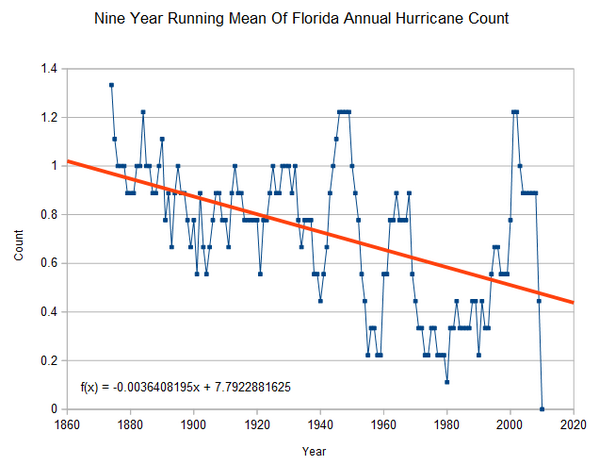Today marks nine years without a major hurricane (111+ MPH winds) strike in the US, and nine years without a hurricane strike in Florida. Both are records.
During the 19th century Florida averaged more than one hurricane per year, but that number has dropped in half.



Another.. just as predicted by CAGW. (sarc)
Perhaps the hurricanes are hiding at the bottom of the sea with all the warmth?
That’s pretty funny!
This is a travesty. The American people have a right to the proper and customary number of major hurricanes every year.
Progressives, women, children and minorities must focus on this pause in their campaign against carbon dioxide.
We don’t need any of those “old-school” hurricanes. What we need are some of those new fully-programmable hurricanes that can move on shore, with absolutely no damage to fauna/flora or manmade structures, yet deliver massive rains to dry/drought areas, with no flooding or wind damage.
Reblogged this on Climatism and commented:
Extreme weather.
Arctic ice satellite photos from 1969:
http://mashable.com/2014/10/21/scientists-1960s-satellite-climate-data/
Are there fewer hurricanes or fewer hurricanes making landfall in America?
[JST1 said 6:15 pm Are there fewer hurricanes or fewer hurricanes making landfall in America?]
See if this link helps:
http://policlimate.com/tropical/
Clearly Gaia is re-loading.
There has been NO hurricanes making landfall in Florida for over nine years. I don’t know how you calculate 1.2, 1.3 etc. hurricanes.
I’m going right out on a limb here and suggesting that “Nine Year Running Mean” would imply that the data has been smoothed. Actual hurricane data looks very noisy.
I think that’s (0+0+0+0+0+0+0+0+0)/9=0 as the last data point shows.
We can’t seem to even get CAT .6 hurricanes like Irene anymore.
Ike? 2008, 145 mph, $37.5 billion damage;Sandy? 2012, 115 mph, $68 billion damage; Irene? 2011,120 mph, $16.6 billion damage. What was the point you were making about a nine year absence of hurricanes over 111 mph? These were Cat 3s and 4s, both over 111 mph.
Please explain your post sufficiently or retract it if you can’t, then admit erroroneous stats.
“Today marks nine years without a major hurricane (111+ MPH winds) strike in the US…”
The U.S. is not at zero yet because you have to count Ike, Sandy and Irene as U.S. hurricanes over 111 mph.
A big hail storm now does more property damage than a major hurricane did 70 years ago. Do you have any idea how stupid your argument is?
you may edit my erroneous spelling of erroneous.
And Alex…2010, 110 mph (missed your cutoff of a Cat 3 by one mph…) a “paltry” $1.89 billion in damage, affected Texas. Hurricane Edouard on Sept. 17, 2014 did not hit Florida land but it was causing some concern because it was a Cat 3 that existed in your 9-year absence period even though it did not hit land it affected Florida and Georgia, while two men drowned off the coast of Maryland because of the rip tides. A Cat 3 that missed, but killed some Americans.
On another climate debate, it has been a really hot fall…
“The current average temperature for October 2014 is 55.5 degrees. If we stay on that track, this October will rank in the top 10 for warmest Octobers on record… barely. The 10th warmest October came in 1910 when Denver averaged 55.4 degrees for the month.
There are still 11 days left until October comes to a close. A lot can happen in 11 days. But if you have noticed, it’s been pretty warm along the Front Range lately, you are right. We will be watching the forecast for the rest of the month, waiting to see if 2014 makes it into the record books.” – http://www.9news.com/story/weather/2014/10/21/warm-october-no-snow-2014/17670253/
And so you know that I know that temperature records are not climate, here is a textbook example (If there were any non-pro-AGW textbooks in existence) that there can be temperature variation on a record setting day in a metropolitan area with temperature gauges less than 20 miles apart :
– from webpage http://www.thorntonweather.com/blog/thornton-weather/denver-sets-record-high-temperature-for-october-15/
“As expected, temperatures in the Mile High City today were unseasonably warm and climbed to record-setting levels. However, while Denver broke a high temperature record, Thornton fell quite a ways short.”
“Out at Denver International Airport, the mercury topped out at 83 degrees. This bested the previous record high for the date of 82 degrees set in 2011 and previous years.”
“Here in Thornton, the cloud cover arrived earlier than the airport and impacted our readings. We saw a maximum today of 77.9 degrees.”
That’s FIVE degrees difference, and Thornton is CLOSER to downtown Denver than the airport is. Did Denver really have a new record (the temperature station at DIA is suspect as a representative location for a Downtown Denver temperature proxy…